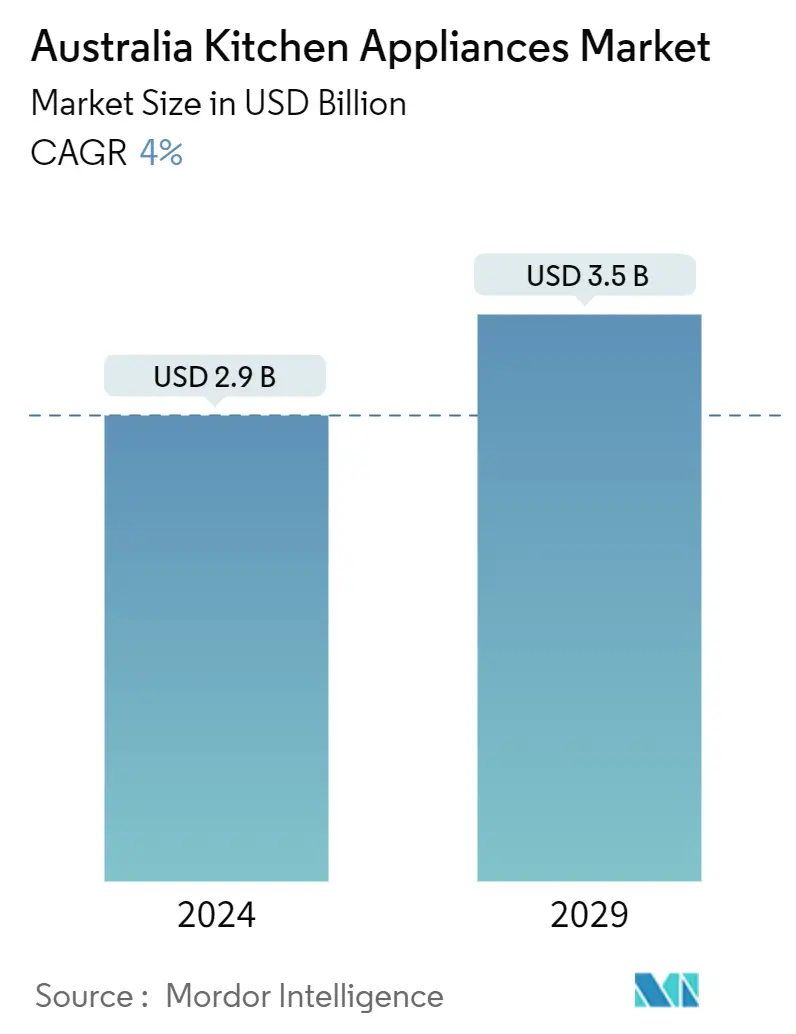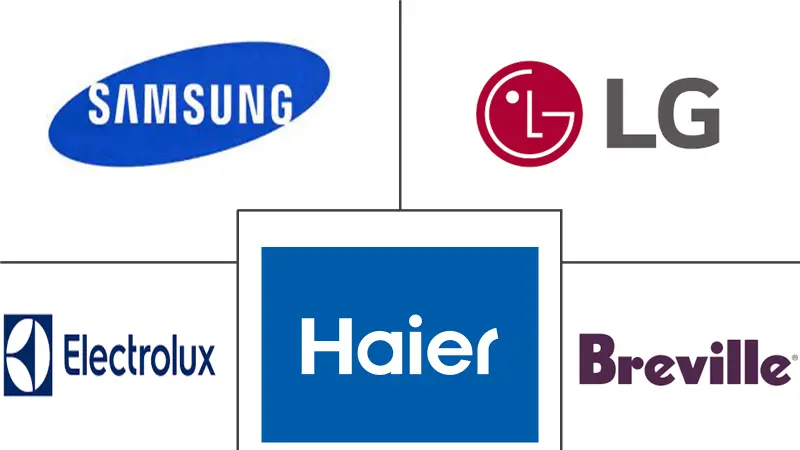Market Size of Australia Kitchen Appliances Industry

| Study Period | 2020 - 2029 |
| Base Year For Estimation | 2023 |
| Market Size (2024) | USD 2.9 Billion |
| Market Size (2029) | USD 3.5 Billion |
| CAGR (2024 - 2029) | 4.00 % |
| Market Concentration | Low |
Major Players
*Disclaimer: Major Players sorted in no particular order |
Australia Kitchen Appliances Market Analysis
The Australia Kitchen Appliances Market size is estimated at USD 2.9 billion in 2024, and is expected to reach USD 3.5 billion by 2029, growing at a CAGR of 4% during the forecast period (2024-2029).
The kitchen appliances market in Australia is significant and continues to grow. Factors like urbanization, a growing population, and an increasing focus on home cooking fuel the demand for modern and convenient kitchen appliances. Moreover, busy schedules and rapid changes in lifestyle are further fueling the demand for kitchen appliances, which make life more comfortable and easier. Additionally, innovations in technology and rising investments in research and development of various electric kitchen appliances are anticipated to drive the growth of the Australian kitchen appliances market during the forecast period. There is also rapid change in the way consumers shop for kitchen appliances. Residential building construction is forecast to increase over the period, supporting industry growth. In addition, household incomes are projected to rise over the next five years, with consumer sentiment remaining positive.
During the initial stage of COVID-19, the market experienced losses due to stoppages in manufacturing and distribution services caused by supply chain disruptions. Later, due to lockdowns and the work-from-home culture, the demand for kitchen appliances rose. Post-COVID, the market is experiencing gradual growth according to seasonal demand fluctuations.
Australian consumers prioritize convenience, energy efficiency, and aesthetics when it comes to kitchen appliances. Products that are easy to use, energy-efficient, and visually appealing perform well in the market. Energy-efficient appliances are highly sought after in Australia due to rising energy costs and a growing awareness of environmental concerns. Appliances with high energy efficiency ratings are popular among consumers. Health-conscious consumers are driving the demand for appliances that support healthy cooking and eating habits. Products like air fryers, steam ovens, and blenders for making smoothies are popular. Kitchen appliances are sold through various retail channels, including brick-and-mortar stores, department stores, specialty appliance retailers, and online platforms. Online sales gained traction, particularly for small appliances.
Australia Kitchen Appliances Industry Segmentation
Kitchen appliances, such as refrigerators, stoves, dishwashers, washing machines, tumble dryers, and microwave ovens, are generally found in consumers' kitchens. A complete background analysis of the Australian kitchen appliances market, which includes an assessment of the economy, market overview, market size estimation for key segments, emerging trends in the market, market dynamics, vital competitive profiles, and the impact of COVID-19, are covered in the report. Large kitchen appliances, small kitchen appliances, end users, and distribution channels segment the market. By large kitchen appliances, the market is segmented into refrigerators and freezers, ovens, dishwashers, and other large kitchen appliances. By small kitchen appliances, the market is segmented into food processors, mixers and grinders, grills and toasters, coffee/tea makers, cookers, and other small kitchen appliances (bread makers, air fryers, etc.). By end user, the market is segmented into residential and commercial. By distribution channel, the market is segmented into multi-brand stores, exclusive stores, online channels, and other distribution channels. The market size is provided in terms of value (USD) during the forecast period for all the above segments.
| By Product Type | ||||||||
| ||||||||
|
| By End User | |
| Residential | |
| Commercial |
| By Distribution Channel | |
| Multi-brand Stores | |
| Exclusive Brand Outlets | |
| Online | |
| Other Distribution Channels |
Australia Kitchen Appliances Market Size Summary
The Australian kitchen appliances market is experiencing steady growth, driven by factors such as urbanization, a growing population, and an increasing emphasis on home cooking. The demand for modern and convenient kitchen appliances is further bolstered by busy lifestyles and technological innovations. As consumers seek appliances that enhance comfort and efficiency, the market is witnessing a shift towards energy-efficient and aesthetically pleasing products. The rise in residential construction and household incomes, coupled with positive consumer sentiment, is expected to support the market's expansion over the forecast period. The COVID-19 pandemic initially disrupted the market due to supply chain issues, but subsequent lockdowns and the work-from-home trend increased demand for kitchen appliances, leading to gradual post-COVID growth.
Australian consumers prioritize convenience and energy efficiency in their kitchen appliances, with a strong preference for products that support healthy cooking and align with environmental concerns. The market is characterized by a diverse range of retail channels, including online platforms, which have gained popularity for small appliances. Refrigerators remain essential, with advancements in technology enhancing their appeal. The industry is fragmented, with both international and local players competing for market share. Brands like Samsung, Electrolux, and LG Electronics are prominent, with Samsung leading the market. Recent product launches, such as Breville's InFizz range, highlight ongoing innovation and consumer engagement in the sector.
Australia Kitchen Appliances Market Size - Table of Contents
-
1. MARKET INSIGHTS AND DYNAMICS
-
1.1 Market Overview
-
1.2 Market Drivers
-
1.2.1 Renovation and Home Improvement Drives the Market
-
1.2.2 Consumer Preferences for Convenience is Driving the Market
-
-
1.3 Market Restraints
-
1.3.1 Changing Cultural Preferences are Challenging the Market
-
1.3.2 Price Sensitivity is Hindering the Market Growth
-
-
1.4 Market Opportunities
-
1.4.1 Smart Kitchen Appliances Provides Opportunities for the Market
-
1.4.2 New Cooking Technology is Encouraging the Demand for Kitchen Appliances
-
-
1.5 Industry Value Chain Analysis
-
1.6 Industry Attractiveness - Porter's Five Forces Analysis
-
1.6.1 Bargaining Power of Suppliers
-
1.6.2 Bargaining Power of Buyers
-
1.6.3 Threat of New Entrants
-
1.6.4 Threat of Substitutes
-
1.6.5 Intensity of Competitive Rivalry
-
-
1.7 Insights On Technology Innovation In The Market
-
1.8 Impact of COVID-19 on the Market
-
-
2. MARKET SEGMENTATION
-
2.1 By Product Type
-
2.1.1 Small Kitchen Appliances
-
2.1.1.1 Food Processors
-
2.1.1.2 Mixers and Grinders
-
2.1.1.3 Grills and Toasters
-
2.1.1.4 Coffee/Tea Makers
-
2.1.1.5 Cookers
-
2.1.1.6 Other Small Kitchen Appliances (Bread Makers, Air Fryers, etc.)
-
-
2.1.2 Large Kitchen Appliances
-
2.1.2.1 Refrigerators and Freezers
-
2.1.2.2 Ovens
-
2.1.2.3 Dishwashers
-
2.1.2.4 Other Large Kitchen Appliances
-
-
-
2.2 By End User
-
2.2.1 Residential
-
2.2.2 Commercial
-
-
2.3 By Distribution Channel
-
2.3.1 Multi-brand Stores
-
2.3.2 Exclusive Brand Outlets
-
2.3.3 Online
-
2.3.4 Other Distribution Channels
-
-
Australia Kitchen Appliances Market Size FAQs
How big is the Australia Kitchen Appliances Market?
The Australia Kitchen Appliances Market size is expected to reach USD 2.9 billion in 2024 and grow at a CAGR of 4% to reach USD 3.5 billion by 2029.
What is the current Australia Kitchen Appliances Market size?
In 2024, the Australia Kitchen Appliances Market size is expected to reach USD 2.9 billion.

